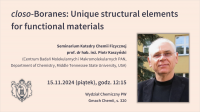Seminarium Katedry Chemii Fizycznej – prof. dr hab. inż. Piotr Kaszyński (Centrum Badań Molekularnych i Makromolekularnych PAN, Middle Tennessee State University, USA)
Zapraszamy na wykład prof. dr hab. inż. Piotra Kaszyńskiego – Centrum Badań Molekularnych i Makromolekularnych Polskiej Akademii Nauk w Łodzi oraz Department of Chemistry, Middle Tennessee State University, USA, pt.
closo-Boranes: Unique structural elements for functional materials.
Termin
15.11.2024 r. (piątek), godz. 12:15
Miejsce
Gmach Chemii, s. 320
Streszczenie
closo-Boranes are inorganic 3-D sigma aromatic compounds with steric and electronic properties attractive for designing multifunctional materials. Earlier work demonstrated that 10- and 12-vertex p-carboranes are suitable building blocks for liquid crystals. Anionic closo-carbaborates have been used to design highly polar materials for LCD applications and ionic self-organizing electrolytes for battery applications. The high-lying HOMO of the decaborate dianion [closo-B10H10]2- has been exploited in the design of materials exhibiting photo-induced intra- and inter-molecular charge transfer processes. The synthesis of these new materials has required the development of new functionalization methods. For example, phenyliodination activates B-H bonds towards highly regioselective nucleophilic substitution.
O prelegencie
Piotr Kaszynski is a Professor of Chemistry at the Centre of Molecular and Macromolecular Studies of Polish Academy of Sciences and University of Łódź in Poland.
He received his M.Sc. degree from Warsaw University of Technology in Poland in 1985, Ph.D. degree in Organic Chemistry in 1991 (University of Texas at Austin), and habilitation in 2007 (University of Łódź).
He spent two years at Caltech as a postdoctoral fellow working in the area of organic magnetic materials, before joining Vanderbilt University in Nashville, TN, USA in 1993.
In 2015 he moved the bulk of his research program to Polish Academy of Sciences, while maintaining ties with Middle Tennessee State University in USA.
His research involves boron clusters and stable radicals and is focused on the design, synthesis and characterization of organic materials for electrooptical, molecular electronics, photovoltaic and spintronic applications and for studying of molecular magnetism in solid-state and liquid crystalline media. He has published over 200 original papers, and several book chapters and reviews.








